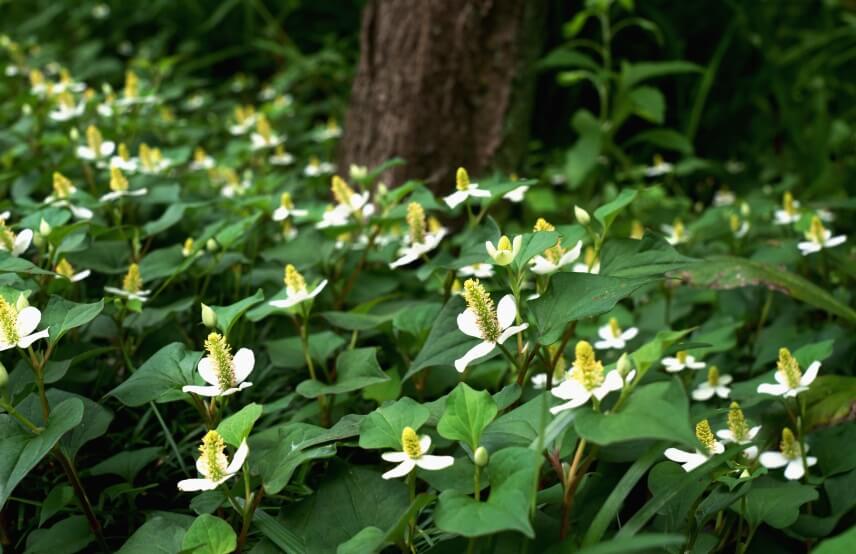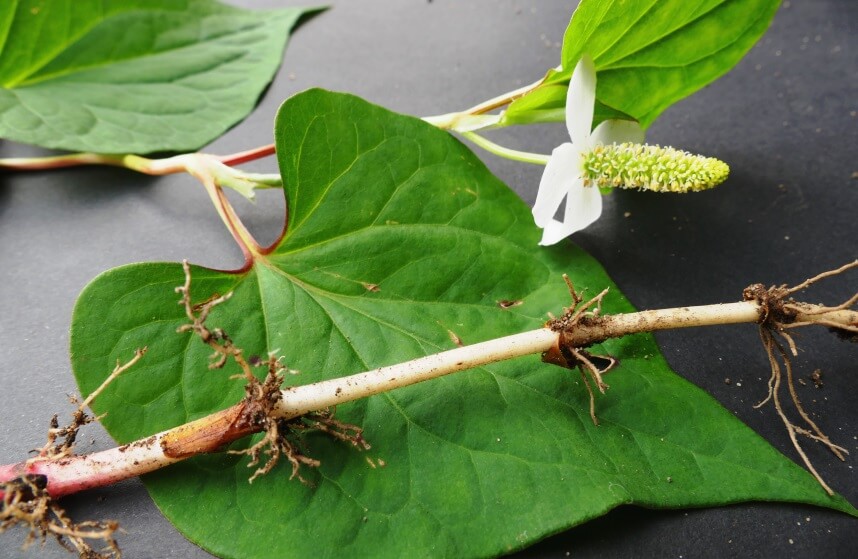Dive into the world of the chameleon plant (Houttuynia cordata), a hidden gem in nature’s medicine cabinet. With leaves that mimic a chameleon’s color-changing magic, this unassuming herb boasts a range of health benefits. From immune-boosting power to anti-inflammatory properties, the chameleon plant has intrigued both traditional healers and modern scientists alike. Join us as we uncover the simple yet powerful secrets and the potential health benefits of chameleon plant.
If you are interested in this topic, you can also read
<<Catnip Benefits>> and <<Chia Seeds Benefits>> articles.

What Is Chameleon Plant?
Houttuynia cordata, also recognized as fish mint, rainbow plant, or chameleon plant, is a flowering species indigenous to Southeast Asia. Named after Martinus Houttuyn, this plant flourishes in moist, shaded areas and adapts well to wet soil or partially submerged conditions, thriving as long as it gets sunlight.
It’s robust root system makes it challenging to control, often becoming invasive in gardens. Beyond its botanical traits, Houttuynia cordata holds cultural significance in Japan, Korea, China, and North-East India. Embraced for its medicinal prowess, it has been traditionally employed to address various health issues, from inflammation and pneumonia to muscular sprains and stomach ulcers [1].
Chameleon Plant Components
Studies exploring the phytochemistry of Houttuynia cordata have revealed a wide range of plant constituents.These include aristolactams, 5,4-dioxoaporphines, oxoaporphines, amides, indoles, ionones, flavonoids, benzenoids, steroids, and various volatile oils. Noteworthy compounds such as Houttuynoside A and houttuynamide A have been specifically identified in this plant. Some of these compounds have undergone assessment for their antioxidant and anti-tyrosinase properties, adding another layer to the multifaceted profile of H. cordata’s chemical composition [2].
Chameleon Plant Benefits
Anti-Mutagenic Activity
The watery extracts from Houttuynia cordata have shown promise in protecting against harmful substances like benzo(a)pyrene, aflatoxin B1, and oxidized frying oil (OFO). The results of the tests indicate that extracts from H. cordata may be beneficial in protecting our bodies against specific harmful agents.
Anti-Inflammatory Activity
Houttuynia cordata’s essential oil has anti-inflammatory properties, functioning like popular anti-inflammatory drugs. Notably, research indicates that extracts from this plant could potentially inhibit inflammatory diseases associated with mast cells. These findings underscore the plant’s intriguing potential in addressing inflammation, aligning with mechanisms found in widely used anti-inflammatory medications [3].
Anti-Obesity Effect
Research suggests that compounds found in Houttuynia cordata may have properties that could help manage obesity. Some studies indicate that certain components in this plant might affect lipid metabolism, potentially aiding in weight control. The oral administration of an aqueous extract from Houttuynia cordata leaves (1 g/kg) demonstrated a significant reduction in corn oil-induced increases in plasma triglyceride levels. Additionally, it effectively inhibited the rise in plasma non-esterified fatty acids and glycerol induced by oleic acid and glycerol, respectively. These results suggest a potential role for H. cordata in regulating lipid levels.
Anti-Bacterial Activities
The water extract of Houttuynia cordata displayed anti-bacterial effects against murine salmonellosis. Its anti-bacterial activity against Salmonella typhimurium increased dose-dependently during an 8-hour incubation. Additionally, the volatile flavor components exhibited strong anti-bacterial activities against Bacillus cereus, Bacillus subtilis, Vibrio cholerae, and Vibrio parahaemolyticus. Other studies noted that both water and ethanol extracts of fresh and dry H. cordata showed anti-microbial activity against Staphylococcus aureus and Escherichia coli, suggesting its potential in combating bacterial infections [4].
Anti-Cancer Activity
It is reported that Houttuynia cordata can cause cancer cells in the colon to undergo a type of natural cell death called apoptosis through a signaling pathway involving mitochondria. This is important because promoting this cell death process and preventing the spread of tumor cells is crucial for treating lung tumors.
In a study using mice with lung tumors, researchers found that H. cordata, along with its active ingredient 2-undecanone, showed anti-tumor effects. So, based on these results, it looks like H. cordata could be a promising option for treating cancer [5].
Anti-Allergic Activity
Taking Houttuynia cordata extracts by mouth at doses of 10 or 100 mg/kg significantly helps with allergic reactions involving mast cells. These reactions are often part of allergic conditions like asthma and allergic rhinitis. So, H. cordata extracts could be useful in easing allergy symptoms.
Anti-Diabetic Activity
The essential oils from Houttuynia cordata can help improve how the body handles fat, urinary albumin, and insulin resistance in diabetes. The water extract of H. cordata is reported to significantly reduce urinary protein, urinary albumin, and certain markers related to kidney health. It also shows a marked improvement in insulin resistance after an 8-week treatment in rats with induced type II diabetes. These results suggest that H. cordata positively affects managing diabetes-related issues.
Antioxidant activity
In the world of modern diseases, issues like oxidative stress and inflammation are widespread. Houttuynia cordata, especially its methanolic extract, has caught attention for its ability to combat these problems.
Traditional herbal medicines, including H. cordata, have been trusted globally for handling diseases tied to oxidative stress and inflammation. Scientifically, studies show that Chameleon plants strategically target pathways to reduce oxidative stress and inflammation effectively.
Key compounds like afzelin, hyperoside, and quercitrin in H. cordata play a crucial role. In experiments and real-life scenarios. These compounds reduce inflammation and exhibit robust antioxidant properties. This harmonious blend of traditional wisdom and scientific findings positions Chameleon as a promising contender in addressing the widespread challenges of oxidative stress and inflammation in our health [6].
Lung Protection
Lung diseases can have various causes, often involving inflammation and acute lung injury (ALI). Houttuynia cordata’s ability to reduce inflammation is crucial for easing these conditions. This effect is linked to certain components in H. cordata, like flavonoids, sodium houttuyfonate, and polysaccharides. In a model induced by lipopolysaccharide (LPS), giving quercitrin from H. cordata by mouth significantly lowered the production of inflammatory substances, suggesting that H. cordata might help relieve lung diseases.
Digestive System Protection
The intestine has protective barriers to prevent damage, including mechanical, chemical, immune, and biological barriers. Houttuynia cordata contributes to this defense mechanism. Its components, such as polysaccharides and sodium houttuyfonate, are found to safeguard the intestinal flora. This extract can strengthen both the mechanical and immune barriers in the intestine, showcasing the role of Chameleon in supporting intestinal health [7].
Reduction Of Liver Damage
Natural substances in plants have proven effective in preventing and treating liver diseases. Some plant compounds like terpenoids, alkaloids, glycosides, and coumarins can inhibit liver fibrosis. Others, like rutin and quercetin, show promise in dealing with cholestasis, a condition affecting bile flow.
Liver cells are sensitive to oxidative stress, and an extract from Houttuynia cordata, known for protecting the liver, demonstrated strong antioxidant activity in a mice model with liver injury. This suggests that H. cordata might help keep the liver healthy by fighting oxidative stress.
Heart Protection
The antioxidants in Houttuynia cordata are noted for intervening in heart remodeling and functional decline. In diabetic conditions, consistent intake of chameleon extract reduced cardiac active oxygen, protein carbonyl, interleukin-6, and inflammatory factors. These findings suggest that H. cordata could positively impact heart health by lessening oxidative stress and inflammation.
Kidney Protection
Kidney diseases are often caused by inflammation, oxidative damage, and other factors that affect the body’s water and salt metabolism. In diabetic mice with kidney injury, treatment with Houttuynia cordata water extract reduced urea nitrogen levels and creatine kinase activity, along with a decrease in the expression of oxidative factors in the kidneys. Inflammation is recognized as a crucial mechanism leading to kidney damage.
Anti-Influenza Virus Activity
In evaluating neuraminidase activity, Houttuynia cordata exhibited robust anti-influenza virus effects, completely inhibiting viral neuraminidase. Additionally, both in vivo and in vitro experiments demonstrated the effectiveness of H. cordata flavonoids against influenza virus H1N1. The combined action of rutin, hyperoside, isoquercitrin, and quercitrin present in the extract significantly improved outcomes, suggesting the potential benefits of the Chameleon plant in countering the influenza virus.
Anti-Coronavirus Activity
Coronaviruses are a group of viruses found in nature, with some specifically infecting humans. Currently, seven types of coronaviruses are known to affect humans. Enzyme and immune regulation are crucial in research against severe acute respiratory syndrome coronavirus (SARS-CoV). Aqueous extracts from Houttuynia cordata effectively boosted the immune system. In this way, Aqueous extracts from Houttuynia cordata can combat coronavirus [8].
Anti-HIV Virus Activity
In the last decade, significant advancements have been achieved in researching natural products for AIDS treatment. Several plants, including Houttuynia cordata and their derivatives, have demonstrated anti-HIV activity [9].
How To Make Chameleon Plant Tea?
Houttuynia cordata, commonly known as fish mint, is a leafy vegetable and a fresh herbal garnish with a distinctive taste attributed to its volatile oil, decanoyl acetaldehyde. This unique flavor, often described as “fishy,” comes from chemical compounds like β-myrcene and 2-undecanone.
Chameleon tea is made by slicing the leaves into small pieces, drying them until they’re crisp, and then boiling them in water until they release a fragrant aroma. After a short simmer, the tea is allowed to cool to the desired temperature [10].
The versatile leaves can be cooked with grilled meats and seafood or used as a garnish in soups, salads, and fresh spring rolls. The edible roots, resembling spaghetti, are known as zhe’ergen in Chinese cuisine and can be consumed raw, cooked, or used as a seasoning. Houttuynia cordata adds a unique and flavorful touch to a variety of dishes in both its leaf and root forms [11].














